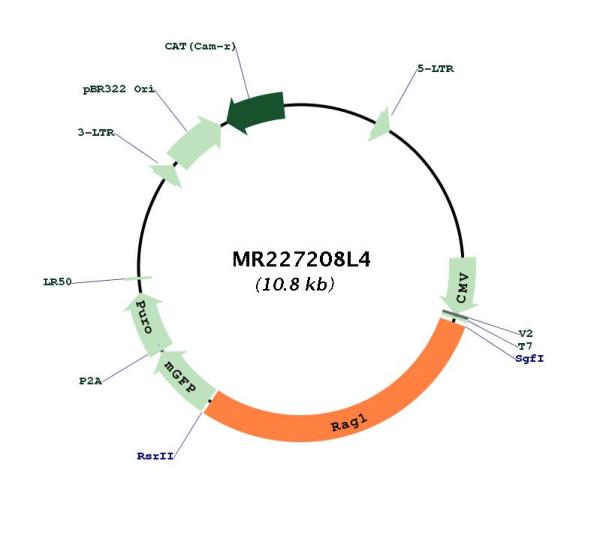Rag1 (NM_009019) Mouse Tagged Lenti ORF Clone
SKU
MR227208L4
Lenti ORF clone of Rag1 (mGFP-tagged) - Mouse recombination activating gene 1 (Rag1)
-
LentiORF®
LentiORF®
Expression-ready ORF plasmid in lenti backbone
Click here to learn more.
| Product Data | |
| Type | Mouse Tagged ORF Clone |
|---|---|
| Target Symbol | Rag1 |
| Synonyms | Rag-1 |
| Vector | pLenti-C-mGFP-P2A-Puro |
| E. coli Selection | Chl (34 ug/mL) |
| Mammalian Cell Selection | Puromycin |
| Sequence Data |
ORF Nucleotide Sequence
The ORF insert of this clone is exactly the same as(MR227208).
|
| Restriction Sites |
SgfI-RsrII Cloning Scheme for this gene
Plasmid Map

|
| ACCN | NM_009019 |
| ORF Size | 3120 bp |
| OTI Disclaimer | The molecular sequence of this clone aligns with the gene accession number as a point of reference only. However, individual transcript sequences of the same gene can differ through naturally occurring variations (e.g. polymorphisms), each with its own valid existence. This clone is substantially in agreement with the reference, but a complete review of all prevailing variants is recommended prior to use. More info |
| OTI Annotation | This clone was engineered to express the complete ORF with an expression tag. Expression varies depending on the nature of the gene. |
| Components | The ORF clone is ion-exchange column purified and shipped in a 2D barcoded Matrix tube containing 10ug of transfection-ready, dried plasmid DNA (reconstitute with 100 ul of water). |
| Reconstitution Method | 1. Centrifuge at 5,000xg for 5min. 2. Carefully open the tube and add 100ul of sterile water to dissolve the DNA. 3. Close the tube and incubate for 10 minutes at room temperature. 4. Briefly vortex the tube and then do a quick spin (less than 5000xg) to concentrate the liquid at the bottom. 5. Store the suspended plasmid at -20°C. The DNA is stable for at least one year from date of shipping when stored at -20°C. |
| Note | Plasmids are not sterile. For experiments where strict sterility is required, filtration with 0.22um filter is required. |
| Shipping | Ambient |
| Reference Data | |
| RefSeq | NM_009019.2, NP_033045.2 |
| RefSeq Size | 6669 bp |
| RefSeq ORF | 3123 bp |
| Locus ID | 19373 |
| UniProt ID | P15919 |
| Cytogenetics | 2 53.88 cM |
| Summary | Catalytic component of the RAG complex, a multiprotein complex that mediates the DNA cleavage phase during V(D)J recombination. V(D)J recombination assembles a diverse repertoire of immunoglobulin and T-cell receptor genes in developing B and T-lymphocytes through rearrangement of different V (variable), in some cases D (diversity), and J (joining) gene segments. In the RAG complex, RAG1 mediates the DNA-binding to the conserved recombination signal sequences (RSS) and catalyzes the DNA cleavage activities by introducing a double-strand break between the RSS and the adjacent coding segment. RAG2 is not a catalytic component but is required for all known catalytic activities. DNA cleavage occurs in 2 steps: a first nick is introduced in the top strand immediately upstream of the heptamer, generating a 3'-hydroxyl group that can attack the phosphodiester bond on the opposite strand in a direct transesterification reaction, thereby creating 4 DNA ends: 2 hairpin coding ends and 2 blunt, 5'-phosphorylated ends. The chromatin structure plays an essential role in the V(D)J recombination reactions and the presence of histone H3 trimethylated at 'Lys-4' (H3K4me3) stimulates both the nicking and haipinning steps. The RAG complex also plays a role in pre-B cell allelic exclusion, a process leading to expression of a single immunoglobulin heavy chain allele to enforce clonality and monospecific recognition by the B-cell antigen receptor (BCR) expressed on individual B-lymphocytes. The introduction of DNA breaks by the RAG complex on one immunoglobulin allele induces ATM-dependent repositioning of the other allele to pericentromeric heterochromatin, preventing accessibility to the RAG complex and recombination of the second allele. In addition to its endonuclease activity, RAG1 also acts as an E3 ubiquitin-protein ligase that mediates monoubiquitination of histone H3. Histone H3 monoubiquitination is required for the joining step of V(D)J recombination. Mediates polyubiquitination of KPNA1.[UniProtKB/Swiss-Prot Function] |
Write Your Own Review
| Product Manuals |
| FAQs |
| SDS |
| SKU | Description | Size | Price | |
|---|---|---|---|---|
| MC223320 | Rag1 (untagged) - Mouse recombination activating gene 1 (Rag1), (10ug) | 10 ug |
$997.00
|
|
| MG227208 | Rag1 (tGFP-tagged) - Mouse recombination activating gene 1 (Rag1), (10ug) | 10 ug |
$1,105.00
|
|
| MR227208 | Rag1 (Myc-DDK-tagged) - Mouse recombination activating gene 1 (Rag1) | 10 ug |
$589.00
MSRP
$905.00
MSRP
$905.00
|
|
| MR227208L3 | Lenti ORF clone of Rag1 (Myc-DDK-tagged) - Mouse recombination activating gene 1 (Rag1) | 10 ug |
$1,205.00
|
|
Citations
*Delivery time may vary from web posted schedule. Occasional delays may occur due to unforeseen
complexities in the preparation of your product. International customers may expect an additional 1-2 weeks
in shipping.










